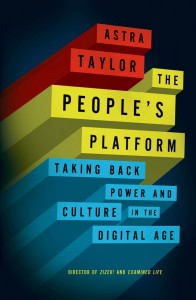For years Full Stop has been posting all of our content on Facebook, happy to take advantage of the free distribution, and it’s mostly worked well. But over the past few months we’ve been noticing that our reach has dwindled. The number of people who see each post is now typically around 5% of the people who like our page. Next to each grim report about our diminishing visibility is an enticement to Boost Post, or pay to get our dispatches out to followers. If you run a page and haven’t already capitulated to the new promotional structure, you’ve probably noticed the same phenomenon.
Full Stop would rather spend our money paying writers for labor-intensive feature pieces, so we’re about to be eclipsed on your Facebook newsfeed by whatever groups you like that are willing and able to play along, and plenty that you don’t like as advertisements continue to creep in. This sidelining of non-commercial actors online should come as little surprise. New media conglomerates are, like other corporations, principally motivated to succeed in an economic system that long predates the Internet. Consequently, as Astra Taylor observes in her new book The People’s Platform: Taking Back Power and Culture in the Digital Age, “the digital economy exhibits a surprising tendency toward monopoly.” In the pixelated realm, as elsewhere, “advantage begets advantage.”
The People’s Platform challenges techno-evangelism and technophobia’s shared preoccupation with rupture, emphasizing continuity instead. In Taylor’s thinking, the Internet neither upends a reasonably democratic cultural economy nor dismantles preexisting structural inequality. The digital economy’s character is not primarily disruptive but is instead surreptitiously conservative, set up to both creatively game and ferociously protect the principles of the free market. While the Web can certainly facilitate collaboration and democratic network-building, Taylor endeavors to demonstrate that it’s also an annex of the offline capitalist domain in which, without intervention, wealth and influence become more concentrated over time rather than diffused or dispersed.
“Winner-take-all markets,” Taylor writes, “promote certain types of culture at the expense of others, can make it harder for niche cultures and late bloomers to flourish, and contribute to broader income inequality.” Under these circumstances the techno-utopian promise of a level cultural playing field has gone tremendously unrealized. The People’s Platform registers this failure, and advises that if we want a thriving, equitable and meaningful digital culture, we’ve got to dispute the tech world’s seductive logic of naturally democratizing openness.
* * *
I live in Turkey, where in March Prime Minister Recep Tayyip Erdoğan banned Twitter, a platform popular among his political opponents and instrumental in last year’s Gezi Park protests. It’s also a site where tapes implicating Erdoğan in corruption have been repeatedly leaked in recent months. Though the ban was declared unconstitutional and lifted a few weeks after its implementation, Erdoğan has maintained a strong stance against social media, declaring it a menace to society and vowing to overturn the court ruling.
Twitter executives and Turkish officials began meeting in April amid the government’s calls for Twitter to establish an office in Turkey and pay domestic taxes. When they emerged from these negotiations, Twitter had agreed to ban two whistleblower accounts with a million followers between them. Twitter also agreed to “blur out” content identified as “malicious” by Turkish courts — all this in exchange, presumably, for dropping the taxation issue. Given the outcome, we can reasonably conclude that Twitter’s main concern is not sustaining a platform for dissenting voices, but its own freedom to conduct business in Turkey unobstructed.
While social media giants like Twitter and Facebook have been instrumental in facilitating social movements across the world, their democratic utility does not guarantee their democratic ethos. They are instead predictably and abidingly corporate; the primary freedom they go to bat for is market freedom. Freedom of expression often overlaps with the free market in the short term, but not necessarily — to Taylor’s point — in the long run.
Of course we should demand the right to access and use Internet platforms as we wish. But as Taylor argues, we should also remember the role of private interests in the digital sphere, something habitually overlooked in populist struggles for Internet freedom. I think back to the weeks when Twitter was banned in Turkey, and to the memes that circulated showing the Twitter bird being tear-gassed or held captive in a birdcage. That the bird was in fact a logo for a multi-billion dollar corporation went generally unaddressed. In one popular image the Twitter bird’s beak is sewn shut, a striking visual conflation of free expression and free enterprise.
In this case you might call Twitter a concealed mediator. Early in The People’s Platform Taylor takes up the question of disintermediation, something techno-utopians have promised for decades would be a natural consequence of digital proliferation. The term refers to cutting out the middlemen, entities that control and profit from content distribution and prevent direct transaction. But the Internet is not a tabula rasa for individual inscription — its infrastructure is maintained at every level by corporations, from physical access to digital content. The notion that you could upload something directly onto the Internet without any corporate mediation or profit is misleading at best. Instead of disintermediating, Taylor argues that the Internet has “facilitated the rise of a new generation of mediators,” a category that includes Apple, Amazon, Google, Facebook, Twitter, Spotify, Netflix, and so on. These new mediators are harder to see — their corporateness often camouflaged, as in the Turkish meme scenario — and harder to demand accountability from.
Taylor finds that, despite repeated promises of an “amateur paradise” where direct connectivity would yield a rich and heterogenous online culture, marginalized and non-commercial voices are increasingly squeezed out of the digital mainstream. She argues that this is largely because the new distribution-focused mediators are off the hook for providing appropriate financial compensation where the old mediators (record labels, film studios, book publishers, magazines and newspapers, etc.) were expected to, even if they didn’t always fulfill those expectations. The resulting freelance economy, Taylor observes, is one in which more and more artists work on spec, with no institutional support or protection during the creative process and no compensation until they fork over a finished product. Cultural producers become true entrepreneurs, and therefore lightning rods for risk. Not everyone is able to bear that risk, which skews the participatory demographics in favor of those with cultural and financial capital.
In this climate of dwindling accountability and accelerating inequality, Taylor calls for a revival of responsible cultural institutions. She argues that without institutional support — like healthy advances to sustain authors working on a book, musicians working on a record, or journalists working on a story — in-depth, ambitious, and unconventional work falls through the cracks. Institutions provide “capital, legal protection, leverage, and also continuity, facilitating the transmission of knowledge and skills from one generation to the next.” They also aggregate risk, meaning that they use the money from successful ventures to support less profitable projects, promoting experimentation and diversity.
While new media triumphalists cheer the collapse of an ailing institutional model and the dawn of the flexibility age, Taylor registers a host of persuasive objections. First, the old media titans aren’t dead, often having struck up partnerships with the new media conglomerates, or purchased them, or been purchased by them. There’s been no great dethroning or fundamental break in the chain of command. Second, new leviathans have arisen, and they demonstrate less and less financial responsibility to working artists, for whom flexibility and precarity are two sides of the same coin. Third, the problem with the old model wasn’t the existence of media institutions themselves, but their elitism and the concentration of wealth and power within their upper echelons. That concentration has not diffused — indeed, an even bigger money and influence gap now separates cultural producers from the mediators who profit from the distribution of their work. Taken together, Taylor’s fresh clarifications of the state of digital culture reveal tech boosterism as a smokescreen behind which economic exploitation of creative labor continues, even intensifies.
Taylor’s proposed solution, unfolded with polemic elegance over the course of her book, is a shift in policy that will regulate the activity of web conglomerates and expand public subsidies for cultural institutions. Policy needs to address a variety of issues including net neutrality, user privacy and software production, limiting large media corporations and promoting artists at every turn. For instance, Taylor proposes a very practical overhaul of the copyright system, which would make it difficult for corporations to exploit copyright laws at artists’ expense, but would not obliterate copyright outright — after all, artists need a way to legally demand compensation for use of their work.
In addition to restrictive policy changes, Taylor makes a strong case that we need to start funneling public money into culture, much in the spirit of the 1965 decision to found the National Endowment for the Arts but adapted for the digital environment. We’re operating currently under the interlocking illusions that the open Internet will naturally lead to a flourishing cultural economy, that entrepreneurial cultural workers will inevitably be more inventive, and (most essentially) that in the free market the public will always act in its own interest. “Yet as we know,” Taylor writes, “open systems can be starkly inegalitarian and open markets cannot be counted on to provide everything people want or need,” especially not what we need. Only a deliberate corrective investment in public goods like art and journalism — against the seductions of immediacy, efficiency, virality and short-term profitability — can protect culture from subsumption.
Taylor took time off writing this book to participate in Occupy’s Strike Debt campaign, helping organize its innovative Rolling Jubilee. In keeping with that sprit of activism, The People’s Platform refuses an attitude of political despondency. This book is a clear-eyed work of civic journalism, starting from the assumption that readers are active agents of change rather than passive consumers of information. A book concerned not only with illuminating the present but also influencing the future, The People’s Platform is both a political catalyst and a tool for action.
Taylor advocates no mass unplugging — it’s inconceivable, and besides the driving force behind escalating digital inequality is not the Internet itself but the free market ethos that pervades it. Instead she calls for a counter-effort, starting with a rejection of the giddy and naive libertarianism that suffuses the mainstream tech conversation. Sink-or-swim will not yield a sustainable digital culture, Taylor warns. We’ve got to establish structural support for experimental and in-depth creative work online if we want that work to remain possible. More fundamentally, we must start prioritizing public good over private gain instead of treating them like synonyms.
This post may contain affiliate links.








